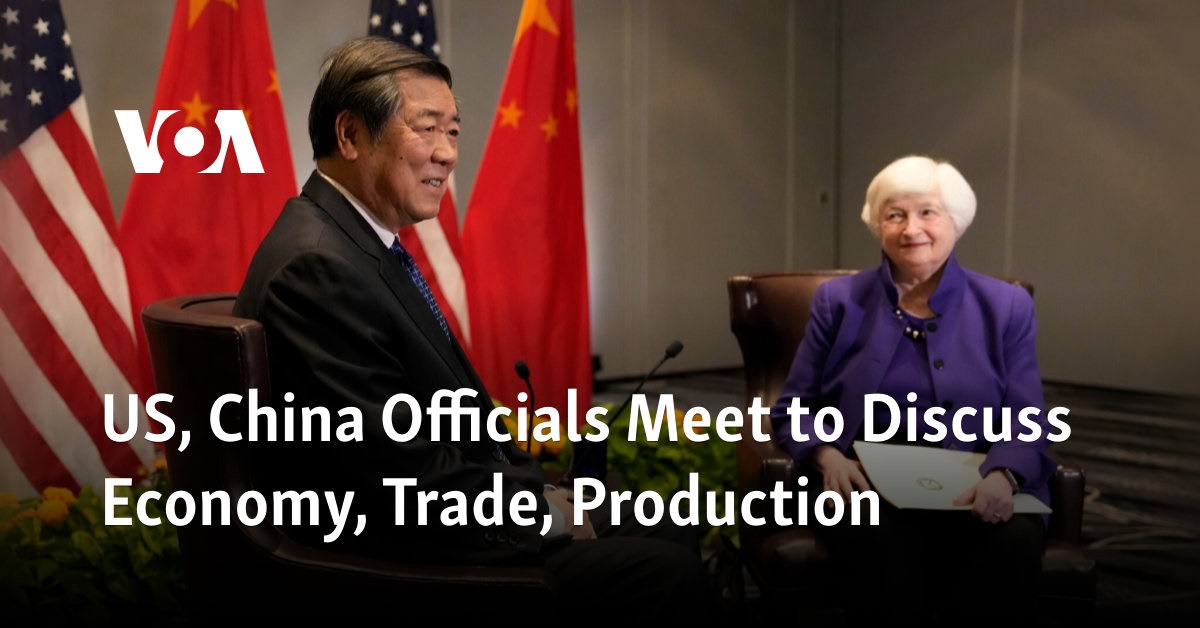U.S.-China Trade Talks: De-escalation Efforts This Week

Table of Contents
Key Objectives of the U.S. in the Trade Talks
The United States enters these U.S.-China trade talks with several key objectives aimed at rebalancing the economic relationship and ensuring fair competition.
Reducing the Trade Deficit
A primary goal for the U.S. is significantly reducing its substantial trade deficit with China. This involves addressing practices deemed unfair and harmful to American businesses.
- Intellectual property theft: China's alleged theft of intellectual property from American companies has cost U.S. businesses billions of dollars.
- Forced technology transfer: American companies operating in China have been pressured to share their technology with Chinese counterparts.
- Subsidies to state-owned enterprises: Chinese government subsidies give state-owned enterprises an unfair advantage over their American competitors in various sectors, including agriculture and manufacturing.
The U.S. aims to see concrete actions to address these issues, potentially through specific targets for reduced trade imbalances in key sectors. Data from the U.S. Census Bureau shows a persistent and significant trade deficit with China, totaling hundreds of billions of dollars annually.
Protecting American Industries
These U.S.-China trade talks are crucial for protecting American industries from unfair competition. The aim is to level the playing field and ensure the survival and growth of American businesses and jobs.
- Agriculture: American farmers have been significantly impacted by Chinese tariffs and trade restrictions.
- Manufacturing: Many American manufacturing sectors face intense competition from Chinese companies benefiting from government support and allegedly unfair practices.
- Technology: The technology sector is particularly vulnerable to intellectual property theft and forced technology transfer.
The U.S. may seek increased market access for American products and measures to counteract unfair trade practices, potentially including adjustments to tariffs or other trade barriers.
Ensuring Fair Trade Practices
The overarching goal is to establish a more equitable and transparent trade relationship with China, adhering to international trade rules and norms.
- Subsidies: The U.S. aims to see a reduction in government subsidies provided to Chinese companies, which distort market competition.
- Dumping: The practice of selling goods below cost to gain market share is a major concern, and the U.S. seeks measures to prevent this.
- Non-tariff barriers: China's complex regulatory environment and non-tariff barriers create significant hurdles for American businesses seeking to operate in the Chinese market.
The implications of these unfair practices extend beyond the U.S., impacting global economic stability and fair competition internationally.
China's Stance and Negotiation Strategies
China's approach to these U.S.-China trade talks is influenced by its own economic priorities and domestic considerations.
Economic Growth and Domestic Concerns
China's continued economic growth is paramount, and any concessions made during these negotiations must be carefully weighed against their potential impact on domestic economic stability and job creation.
- Maintaining economic growth: China faces pressure to maintain high economic growth rates to ensure social stability.
- Technological advancement: China is committed to becoming a global leader in technology, and this ambition might influence its negotiating position.
- Political considerations: Domestic political factors and the government's desire to maintain control will likely play a significant role.
China's potential concessions will be carefully calibrated to minimize negative impacts on its economy and strategic goals.
Counterarguments and Proposals
China is expected to present counterarguments to the U.S. demands, highlighting its own contributions to global trade and disputing accusations of unfair practices.
- Dispute over trade deficit figures: China may challenge the U.S.'s calculations of the trade deficit.
- Defense of industrial policies: China might defend its industrial policies as necessary for economic development.
- Calls for reciprocal market access: China is likely to demand greater market access for its own products in the United States.
China's negotiation strategy will likely involve a combination of compromise and resistance, aiming to secure favorable terms while avoiding significant economic setbacks.
Global Impact of China's Actions
China's trade policies and actions significantly influence global markets and supply chains. The impact of these U.S.-China trade talks extends far beyond the two countries involved.
- Global supply chains: Disruptions to U.S.-China trade can disrupt global supply chains, impacting businesses worldwide.
- Developing countries: Developing countries that rely on trade with either China or the U.S. are particularly vulnerable to the consequences of trade disputes.
- International trade rules: The outcome of these talks could set a precedent for future international trade negotiations.
Potential Outcomes and Their Global Implications
The outcome of these U.S.-China trade talks could have significantly different global implications.
Scenario 1: Successful De-escalation
A successful negotiation could lead to several positive outcomes, boosting global economic confidence.
- Reduced tariffs: A reduction or elimination of tariffs would benefit businesses and consumers in both countries and globally.
- Increased trade: Improved trade relations would lead to increased trade volumes and economic growth.
- Strengthened international relations: A successful resolution would contribute to improved international cooperation and stability.
This scenario would likely result in increased investor confidence and a more positive global economic outlook.
Scenario 2: Stalemate or Escalation
Failure to reach an agreement could have severe negative consequences.
- Increased tariffs: Further escalation could lead to higher tariffs and increased trade barriers, harming businesses and consumers.
- Trade war: A full-blown trade war would have devastating consequences for the global economy.
- Geopolitical instability: Increased tensions between the U.S. and China could destabilize the global geopolitical landscape.
This scenario would likely lead to decreased investor confidence and a slowdown in global economic growth.
The Role of Other Global Players
Other countries and international organizations may play a role in influencing the outcome of these U.S.-China trade talks.
- The World Trade Organization (WTO): The WTO could be involved in mediating disputes or providing a framework for resolving trade disagreements.
- The European Union: The EU has its own significant trade relationship with both China and the U.S. and has a stake in the outcome.
- Other Asian economies: Countries in Asia heavily reliant on trade with China and the U.S. would be significantly impacted.
The actions and influence of these global players could either facilitate a successful de-escalation or exacerbate tensions.
Conclusion: U.S.-China Trade Talks: A Path Towards De-escalation
These U.S.-China trade talks are critically important for both countries and the global economy. The key objectives of the U.S., including reducing the trade deficit, protecting American industries, and ensuring fair trade practices, are being met with China's own priorities of economic growth and domestic concerns. The potential outcomes, ranging from successful de-escalation to a further escalation of trade tensions, have profound global implications. Staying informed about the developments in these crucial U.S.-China trade negotiations and their impact on global commerce is essential. The path towards de-escalation requires careful diplomacy and a commitment from both sides to finding a mutually beneficial solution. Stay tuned for updates on these crucial U.S.-China trade talks as we continue to monitor the de-escalation efforts and their impact on global commerce.

Featured Posts
-
 Vu Viec Bao Mau Danh Tre O Tien Giang Can Nhung Bien Phap Manh Tay Hon De Bao Ve Tre Em
May 09, 2025
Vu Viec Bao Mau Danh Tre O Tien Giang Can Nhung Bien Phap Manh Tay Hon De Bao Ve Tre Em
May 09, 2025 -
 Wheelchair Accessibility Challenges And Solutions On The Elizabeth Line
May 09, 2025
Wheelchair Accessibility Challenges And Solutions On The Elizabeth Line
May 09, 2025 -
 From Underdogs To Champions Luis Enriques Psg Transformation
May 09, 2025
From Underdogs To Champions Luis Enriques Psg Transformation
May 09, 2025 -
 Tham Kich O Tien Giang Can Siet Chat Quan Ly Hoat Dong Giu Tre
May 09, 2025
Tham Kich O Tien Giang Can Siet Chat Quan Ly Hoat Dong Giu Tre
May 09, 2025 -
 Stephen Kings Thoughts On Stranger Things And It A Comparison
May 09, 2025
Stephen Kings Thoughts On Stranger Things And It A Comparison
May 09, 2025
